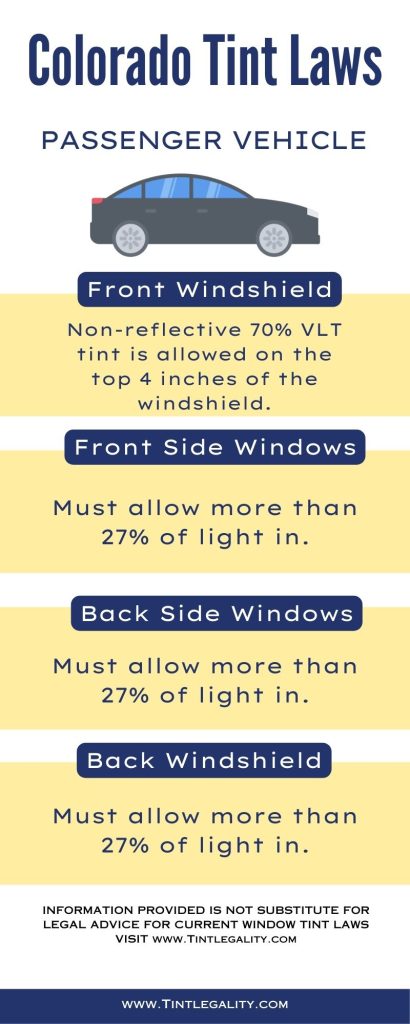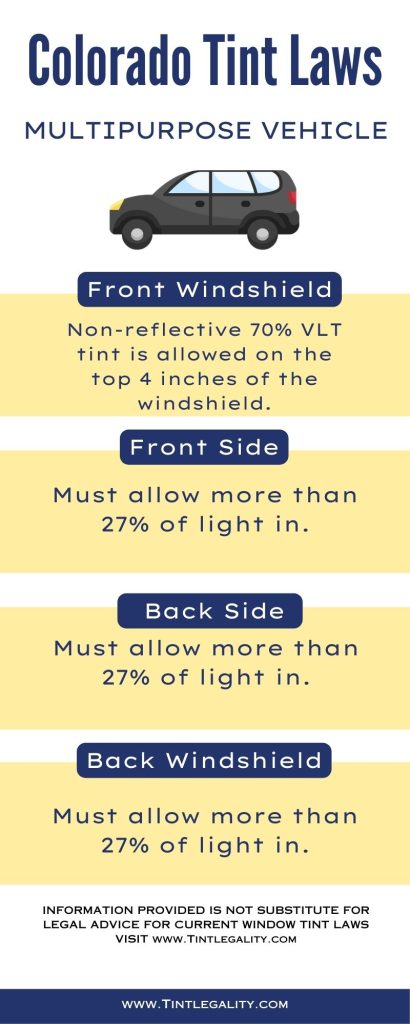If you live in Colorado or plan on driving through the state, it’s essential to know about Colorado tint laws.
Enacted in 1995, these laws regulate the amount of tint allowed on the windows of cars, trucks, and other vehicles.
Failure to comply with these laws can result in hefty fines, so it’s essential to understand the rules before installing window tint.
Regulations Regarding Window Tint Laws In Colorado
Colorado law regulates the amount of tint allowed on different windows of a vehicle. The regulations vary depending on the type of window and the location of the vehicle.
| Window | Tint Limit | Penalties for Breaking the Law |
|---|---|---|
| Windshield | 4-inch strip at top only | Warning and $50 fine for a first offense |
| Front Side Windows | Up to 27% VLT | $100 fine for a second offense |
| Back Side Windows | Any level of tint, as long as dual side mirrors are present | $500 fine for a third offense |
| Rear Window | Any level of tint, as long as dual side mirrors are present | Vehicle registration may be suspended until tint is removed |
Windshield
The windshield is the most important window on any vehicle, and Colorado law has strict regulations regarding the amount of tint allowed on the windshield.
According to Colorado tint laws, no tint is allowed on the front windshield, except for a 4-inch strip at the top of the windshield.
Front Side Windows
Colorado tint laws allow for up to 27% visible light transmission (VLT) on the front side windows.
This means that the window must allow at least 27% of the outside light to pass through the window.
Back Side Windows
Backside windows refer to the windows behind the driver’s seat. Colorado law allows for any level of tint on back side windows, provided that the vehicle has dual side mirrors.
Rear Window
The rear window is the back windshield of the vehicle. According to Colorado Tint laws 2023, any level of tint is allowed on the rear window, as long as the vehicle has dual-side mirrors.


Additional Regulations
In addition to the regulations regarding the amount of tint allowed on windows, Colorado law has several other regulations that drivers must follow.
Reflection
Colorado tint laws prohibit any window tint that reflects more than 25% of the light that strikes it.
This rule is designed to prevent the use of highly reflective tint that can cause glare for other drivers.
Medical Exemptions
Drivers who have a medical condition that requires tinted windows may be exempt from some of the Colorado tint laws.
To qualify for a medical exemption, drivers must have a statement from a licensed physician indicating that the tint is necessary for their medical condition.
Color Restrictions
Colorado law does not allow the use of any tint that is red, blue, or amber in color. These colors are reserved for emergency vehicles and cannot be used on regular vehicles.
Side Mirrors
According to Colorado tint laws, if a vehicle has tinted back side windows, it must have dual side mirrors.
This requirement is designed to ensure that drivers have adequate visibility on the road.
Exceptions to Legal Limits
There are some exceptions to the legal limits on tint in Colorado. For example, limousines and hearses are allowed to have darker tint on all windows.
Additionally, vehicles that were manufactured with tinted windows are allowed to have tint that is darker than the legal limit.
Penalties for Breaking the Law
If a driver is caught with illegal window tint, they may face fines and other penalties.
Fines
The fines for violating CO tint laws can range from $50 to $500, depending on the severity of the offense.
First Conviction
If a driver is convicted of violating Colorado tint laws for the first time, they will receive a warning and a $50 fine.
Second Conviction
If a driver is convicted of violating Colorado tint laws for the second time, they will receive a $100 fine.
Third Conviction
If a driver is convicted of violating Colorado tint laws for the third time, they will receive a $500 fine.
Other Penalties
In addition to fines, drivers who violate Colorado tint laws may also face other penalties, such as having their vehicle impounded.
Penalties for Non-Compliance
If a driver refuses to remove illegal window tint, they may have their vehicle registration suspended until they comply with the law. Additionally, if a driver is involved in an accident and has illegal window tint, their insurance company may refuse to cover the damages.
Benefits of Legal Tint
While there are penalties for violating Colorado tint laws, there are also benefits to having legal tint on your windows. Tinted windows can provide a number of benefits, including:
- Reduced glare: Tinted windows can reduce the amount of glare from the sun and other vehicles on the road, making it easier to see while driving.
- Increased privacy: Tinted windows can increase the privacy of the vehicle’s occupants, making it harder for outsiders to see inside.
- Protection from UV rays: Tinted windows can protect the vehicle’s interior from UV rays, which can cause damage over time.
FAQ’s
What is the highest legal tint in Colorado?
The highest legal tint in Colorado is 27% VLT for front side windows.
Can you get pulled over for tint in Colorado?
Yes, you can get pulled over for illegal tint in Colorado.
Is it illegal to tint your front windows in Colorado windows?
Yes, it is illegal to tint front side windows in Colorado, except for a 4-inch strip at the top.
Is 20% tint legal in Colorado?
No, 20% tint is not legal for front side windows in Colorado.
References: